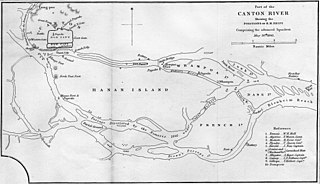
The Republic of China Military Academy is the military academy for the army of the Republic of China, located in Fengshan District, Kaohsiung. Previously commonly known as the Whampoa Military Academy, the military academy produced many prestigious commanders who fought in many of China's conflicts in the 20th century, notably the Northern Expedition, the Second Sino-Japanese War and the Chinese Civil War.
Whampoa is a romanisation of 黄埔, the name of Huangpu District, Guangzhou, China. It may refer to:
Huangpu, also formerly romanized Whangpoo or Whang-Po, may refer to:
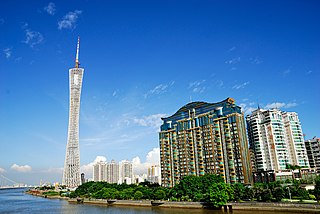
Haizhu District is one of the ten districts in Guangzhou, capital of Guangdong province, People's Republic of China.
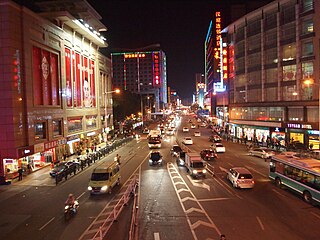
Panyu, formerly romanized as Punyu, is a district of Guangzhou, the capital of Guangdong province in southern China. It is the site of the oldest parts of Guangzhou, dating back to the Qin Empire, although it was a separate county-level city before its incorporation into modern Guangzhou. The present district covers an area of about 661.88 square kilometres (255.55 sq mi).
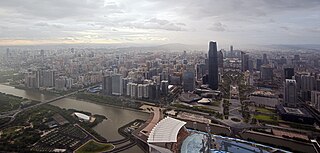
Tianhe District is one of the eleven districts of Guangzhou, the capital of Guangdong province. In Chinese, the name Tianhe literally means "a river in the sky/heavens", which is also a Chinese name for the Milky Way. It is bordered by Yuexiu District on the west, Baiyun District on the north and Huangpu District on the east. Haizhu District is on its south, though they are separated by the Pearl River.
Port of Guangzhou is the main seaport of Guangzhou city, Guangdong province, China. The port is operated by Guangzhou Port Group Co. Ltd which is a state owned company. The company was established on February 26, 2004 from the former Guangzhou Harbor Bureau. It was approved by the Guangzhou Municipal Government. It is currently the largest comprehensive port in South China. Its international maritime trade reaches over 300 ports in more than 80 countries and districts worldwide. The port also incorporates the former Huangpu Port.

Huangpu (help·info), formerly romanized as Whampoa, is one of the ten districts of Guangzhou, the capital of Guangdong Province, China. Despite its name, it does not include Huangpu Island or its famous anchorage. Huangpu absorbed Guangzhou's former Luogang District in 2014.
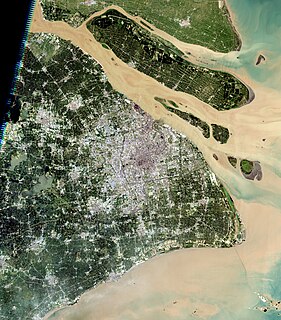
The geography of Shanghai is characterised by its location on the Yangtze River Delta on China's east coast and its proximity to the Pacific Ocean via the East China Sea. The city is centred on the Huangpu River, a tributary of the Yangtze River, and extends outwards in all directions, with the suburbs and satellite towns reaching east to the East China Sea, north and west to Jiangsu province, and south to Zhejiang province over Hangzhou Bay.

Zhujiang New Town or New City is an area in Guangzhou, Guangdong, China. It is bounded by Huangpu Avenue on the north, the Pearl River on the south, Guangzhou Avenue on the west and the South China Expressway on the east.

Chebeinan Station, literally Chebei South Station and formerly Huangzhou Station (黄洲站) when planning, is an interchange station of Guangzhou Metro Line 4 and Line 5. It is located at the underground of the junction of Chebei Road and Huangpu Avenue East in Tianhe District. It opened on 28 December 2009. A public toilet was built outside the station for the convenience of passengers.

Wenchong Station, formerly Wenyuan Station (文圆站), is a terminus of Line 5 of the Guangzhou Metro. It is located under the junction of Dashadi Donglu (大沙地东路) and Shihua Lu (石化路), in the Huangpu District. It opened in December 2009. In the future, Line 5 is planned to be extended from Wenchong Station to the Huangpu Coach Terminal Station.

Dashadi Station, formerly Gangwanlu Station (港湾路站) during planning, is a station on Line 5 of the Guangzhou Metro. It is located underground the junction of West Dashadi Road (大沙地西路) and Gangwan Road (港湾路), in the Huangpu District of Guangzhou, near Huangpu Police Station, Dashadi Shopping City and Huangpu Commercial City. It opened in December 2009.

Pazhou is a subdistrict of Haizhu in southeastern Guangzhou, Guangdong Province, in China.
Luoxi Island is an island in Dashi Town (大石镇), Panyu District, Guangzhou City, Guangdong Province,China. It is located in the northeast of Nanpu Island to the south of Haizhu Island and to the west of Xiaoguwei Island. It is about 9.85 square kilometres (3.80 sq mi) in area and connects to the Guangzhou urban area via the Luoxi Bridge (洛溪大桥), Xinguang Bridge (新光大桥) and Panyu Bridge (番禺大桥).
Shaji is an area adjacent to Yanjiang West Road (沿江西路) in the Liwan District of Guangzhou City, Guangdong Province, China. It lies opposite Shamian Island where on 23 June 1925, there was a massacre in which Chinese demonstrators and one French merchant died in an exchange of fire between British and French marines guarding the foreign concessions and cadets from the Whampoa Military Academy.

The Pazhou Pagoda, also known as the Whampoa Pagoda or Pa Chow Pogoda, is an ancient Chinese pagoda on Pazhou Island in Haizhu District, Guangzhou, the capital of China's Guangdong Province.

Huacheng Square, or Flower City Square, is the largest city square in the city of Guangzhou. The square is situated on the city axis in Zhujiang New Town, occupies a 56-square-kilometre-large (22 sq mi) area with Haixinsha Island to its south and Huangpu Avenue to its north. Guangzhou Opera House, Guangdong Museum and Guangzhou Library are also located around the square.
Guangdong Nanhua Vocational College of Industry and Commerce is a public vocational college in Guangdong, China.









